NUTR73-701: Cancer Patient Nutrition and Dietetic Review
VerifiedAdded on 2023/06/11
|15
|4582
|209
Literature Review
AI Summary
This literature review explores the critical issue of malnutrition in cancer patients, examining the effectiveness of various malnutrition screening tools such as the Malnutrition Universal Screening Tool (MUST) and Patient-Generated Subjective Global Assessment (PG-SGA). It discusses the biological changes and treatment-related side effects that contribute to malnutrition in this population, emphasizing the importance of early identification and nutritional support to improve treatment outcomes and quality of life. Several research articles are reviewed, comparing the sensitivity and specificity of different screening tools in identifying malnutrition and assessing their impact on cancer-related complications. The review highlights the advantages and limitations of each tool, with a focus on the practicality and ease of use of MUST in diverse healthcare settings. The study also compares MUST and PG-SGA, evaluating their effectiveness in determining the nutritional status of cancer patients and identifying areas for further research and development to enhance the accuracy and applicability of these tools.
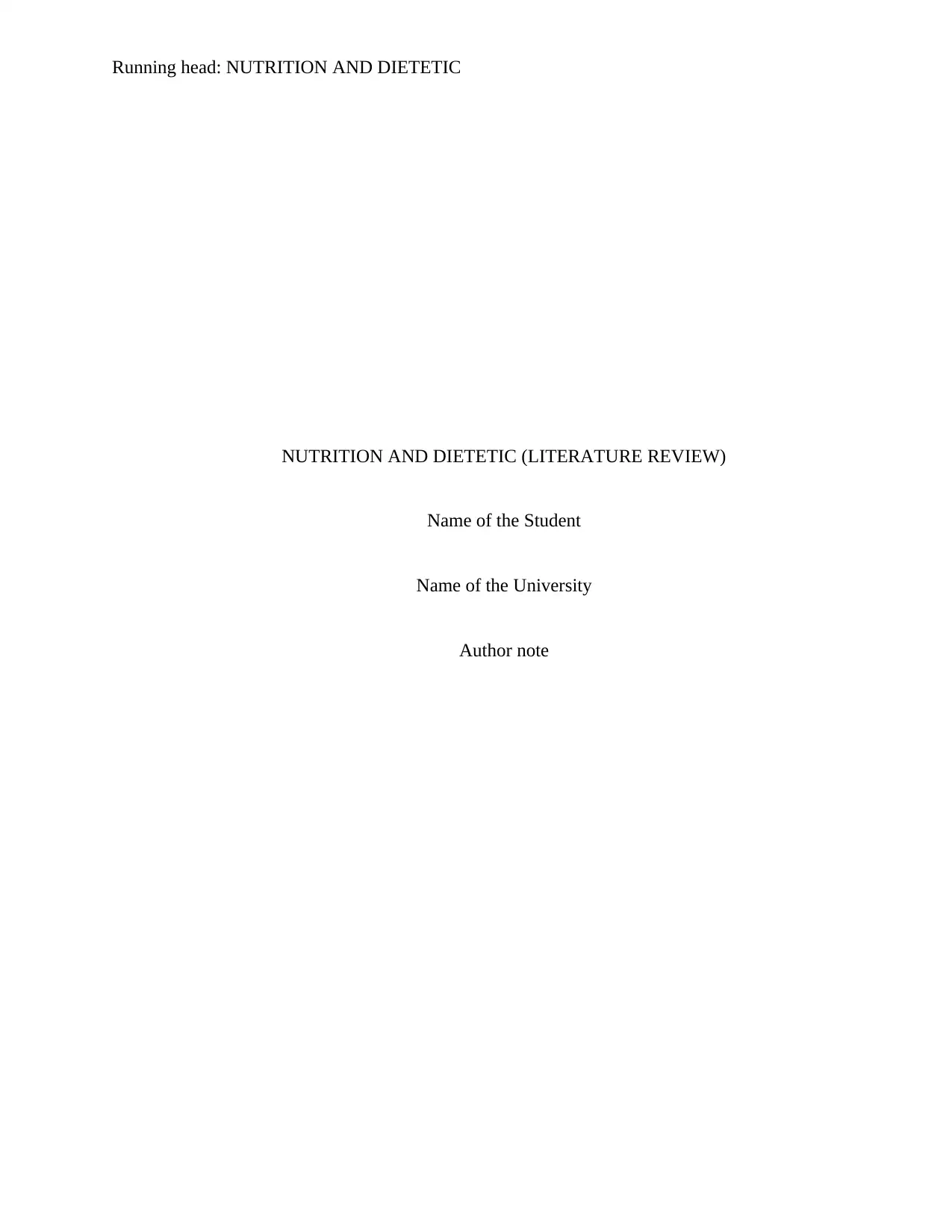
Running head: NUTRITION AND DIETETIC
NUTRITION AND DIETETIC (LITERATURE REVIEW)
Name of the Student
Name of the University
Author note
NUTRITION AND DIETETIC (LITERATURE REVIEW)
Name of the Student
Name of the University
Author note
Paraphrase This Document
Need a fresh take? Get an instant paraphrase of this document with our AI Paraphraser
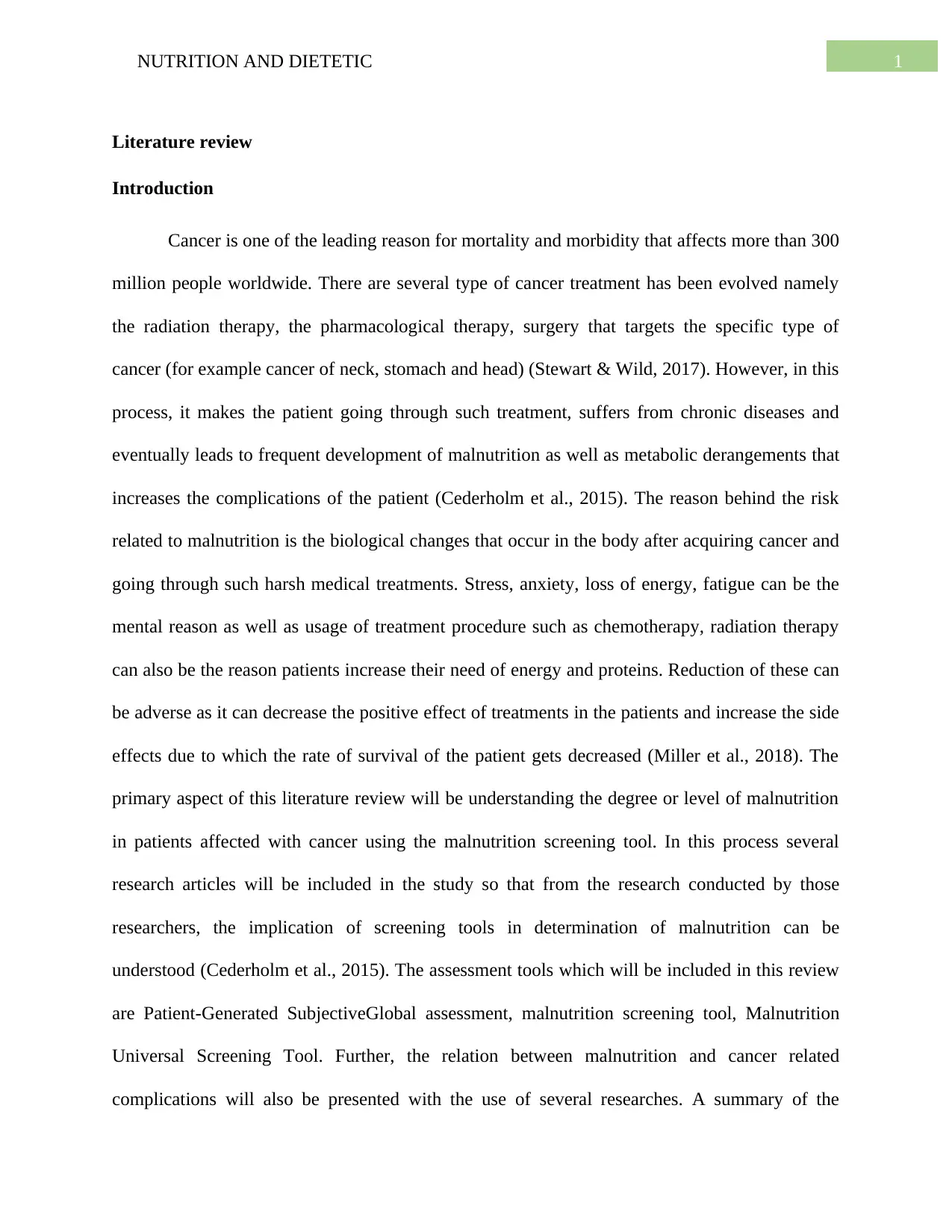
1NUTRITION AND DIETETIC
Literature review
Introduction
Cancer is one of the leading reason for mortality and morbidity that affects more than 300
million people worldwide. There are several type of cancer treatment has been evolved namely
the radiation therapy, the pharmacological therapy, surgery that targets the specific type of
cancer (for example cancer of neck, stomach and head) (Stewart & Wild, 2017). However, in this
process, it makes the patient going through such treatment, suffers from chronic diseases and
eventually leads to frequent development of malnutrition as well as metabolic derangements that
increases the complications of the patient (Cederholm et al., 2015). The reason behind the risk
related to malnutrition is the biological changes that occur in the body after acquiring cancer and
going through such harsh medical treatments. Stress, anxiety, loss of energy, fatigue can be the
mental reason as well as usage of treatment procedure such as chemotherapy, radiation therapy
can also be the reason patients increase their need of energy and proteins. Reduction of these can
be adverse as it can decrease the positive effect of treatments in the patients and increase the side
effects due to which the rate of survival of the patient gets decreased (Miller et al., 2018). The
primary aspect of this literature review will be understanding the degree or level of malnutrition
in patients affected with cancer using the malnutrition screening tool. In this process several
research articles will be included in the study so that from the research conducted by those
researchers, the implication of screening tools in determination of malnutrition can be
understood (Cederholm et al., 2015). The assessment tools which will be included in this review
are Patient-Generated SubjectiveGlobal assessment, malnutrition screening tool, Malnutrition
Universal Screening Tool. Further, the relation between malnutrition and cancer related
complications will also be presented with the use of several researches. A summary of the
Literature review
Introduction
Cancer is one of the leading reason for mortality and morbidity that affects more than 300
million people worldwide. There are several type of cancer treatment has been evolved namely
the radiation therapy, the pharmacological therapy, surgery that targets the specific type of
cancer (for example cancer of neck, stomach and head) (Stewart & Wild, 2017). However, in this
process, it makes the patient going through such treatment, suffers from chronic diseases and
eventually leads to frequent development of malnutrition as well as metabolic derangements that
increases the complications of the patient (Cederholm et al., 2015). The reason behind the risk
related to malnutrition is the biological changes that occur in the body after acquiring cancer and
going through such harsh medical treatments. Stress, anxiety, loss of energy, fatigue can be the
mental reason as well as usage of treatment procedure such as chemotherapy, radiation therapy
can also be the reason patients increase their need of energy and proteins. Reduction of these can
be adverse as it can decrease the positive effect of treatments in the patients and increase the side
effects due to which the rate of survival of the patient gets decreased (Miller et al., 2018). The
primary aspect of this literature review will be understanding the degree or level of malnutrition
in patients affected with cancer using the malnutrition screening tool. In this process several
research articles will be included in the study so that from the research conducted by those
researchers, the implication of screening tools in determination of malnutrition can be
understood (Cederholm et al., 2015). The assessment tools which will be included in this review
are Patient-Generated SubjectiveGlobal assessment, malnutrition screening tool, Malnutrition
Universal Screening Tool. Further, the relation between malnutrition and cancer related
complications will also be presented with the use of several researches. A summary of the
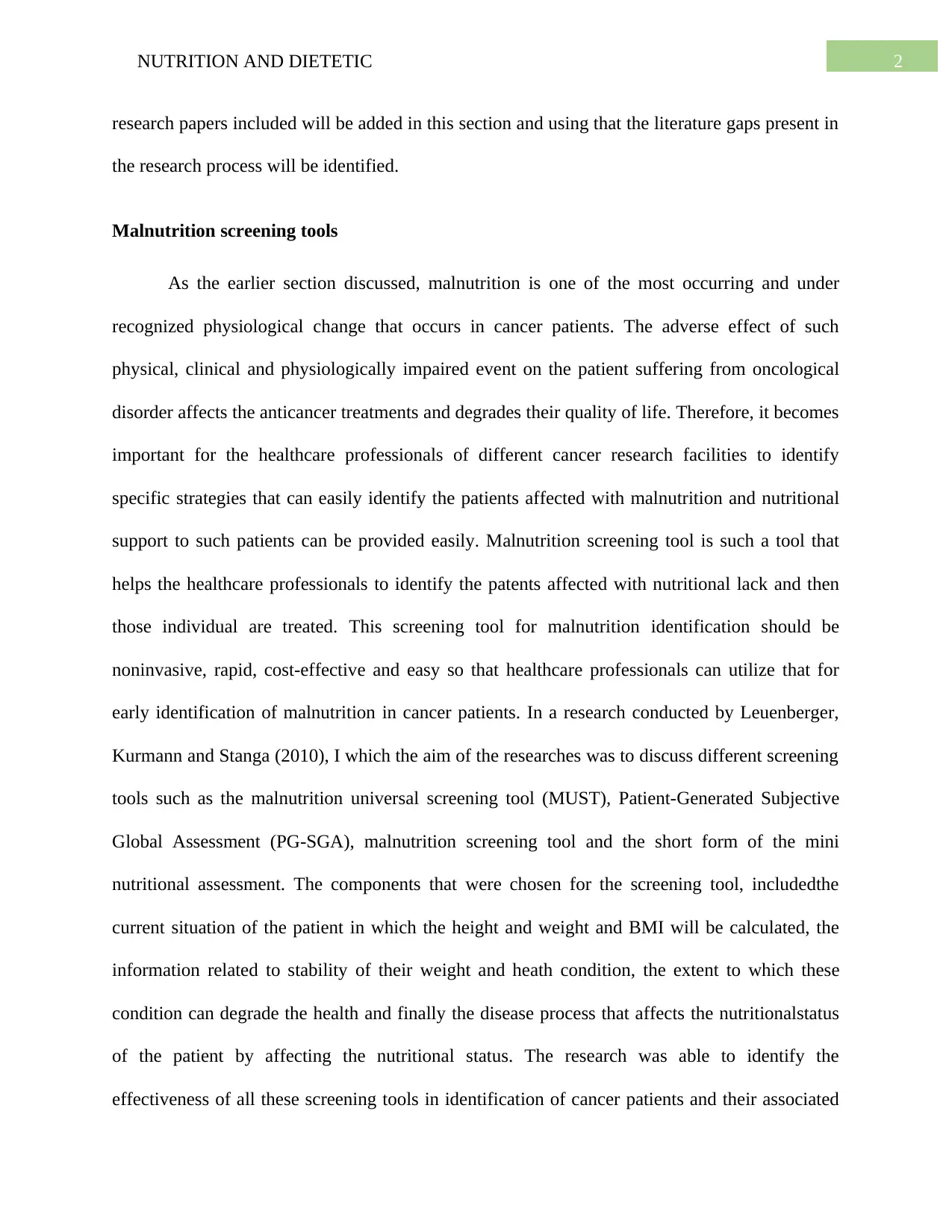
2NUTRITION AND DIETETIC
research papers included will be added in this section and using that the literature gaps present in
the research process will be identified.
Malnutrition screening tools
As the earlier section discussed, malnutrition is one of the most occurring and under
recognized physiological change that occurs in cancer patients. The adverse effect of such
physical, clinical and physiologically impaired event on the patient suffering from oncological
disorder affects the anticancer treatments and degrades their quality of life. Therefore, it becomes
important for the healthcare professionals of different cancer research facilities to identify
specific strategies that can easily identify the patients affected with malnutrition and nutritional
support to such patients can be provided easily. Malnutrition screening tool is such a tool that
helps the healthcare professionals to identify the patents affected with nutritional lack and then
those individual are treated. This screening tool for malnutrition identification should be
noninvasive, rapid, cost-effective and easy so that healthcare professionals can utilize that for
early identification of malnutrition in cancer patients. In a research conducted by Leuenberger,
Kurmann and Stanga (2010), I which the aim of the researches was to discuss different screening
tools such as the malnutrition universal screening tool (MUST), Patient-Generated Subjective
Global Assessment (PG-SGA), malnutrition screening tool and the short form of the mini
nutritional assessment. The components that were chosen for the screening tool, includedthe
current situation of the patient in which the height and weight and BMI will be calculated, the
information related to stability of their weight and heath condition, the extent to which these
condition can degrade the health and finally the disease process that affects the nutritionalstatus
of the patient by affecting the nutritional status. The research was able to identify the
effectiveness of all these screening tools in identification of cancer patients and their associated
research papers included will be added in this section and using that the literature gaps present in
the research process will be identified.
Malnutrition screening tools
As the earlier section discussed, malnutrition is one of the most occurring and under
recognized physiological change that occurs in cancer patients. The adverse effect of such
physical, clinical and physiologically impaired event on the patient suffering from oncological
disorder affects the anticancer treatments and degrades their quality of life. Therefore, it becomes
important for the healthcare professionals of different cancer research facilities to identify
specific strategies that can easily identify the patients affected with malnutrition and nutritional
support to such patients can be provided easily. Malnutrition screening tool is such a tool that
helps the healthcare professionals to identify the patents affected with nutritional lack and then
those individual are treated. This screening tool for malnutrition identification should be
noninvasive, rapid, cost-effective and easy so that healthcare professionals can utilize that for
early identification of malnutrition in cancer patients. In a research conducted by Leuenberger,
Kurmann and Stanga (2010), I which the aim of the researches was to discuss different screening
tools such as the malnutrition universal screening tool (MUST), Patient-Generated Subjective
Global Assessment (PG-SGA), malnutrition screening tool and the short form of the mini
nutritional assessment. The components that were chosen for the screening tool, includedthe
current situation of the patient in which the height and weight and BMI will be calculated, the
information related to stability of their weight and heath condition, the extent to which these
condition can degrade the health and finally the disease process that affects the nutritionalstatus
of the patient by affecting the nutritional status. The research was able to identify the
effectiveness of all these screening tools in identification of cancer patients and their associated
⊘ This is a preview!⊘
Do you want full access?
Subscribe today to unlock all pages.

Trusted by 1+ million students worldwide
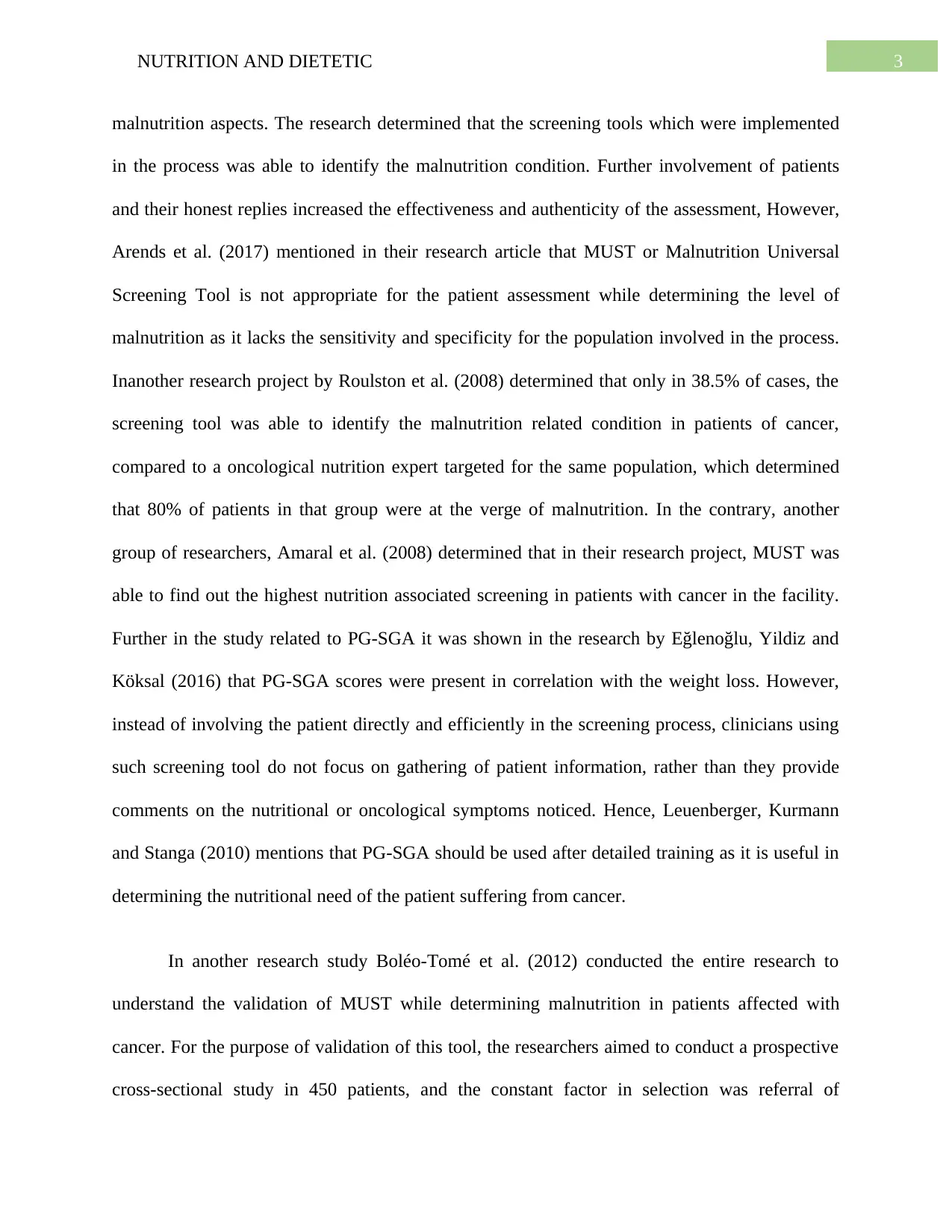
3NUTRITION AND DIETETIC
malnutrition aspects. The research determined that the screening tools which were implemented
in the process was able to identify the malnutrition condition. Further involvement of patients
and their honest replies increased the effectiveness and authenticity of the assessment, However,
Arends et al. (2017) mentioned in their research article that MUST or Malnutrition Universal
Screening Tool is not appropriate for the patient assessment while determining the level of
malnutrition as it lacks the sensitivity and specificity for the population involved in the process.
Inanother research project by Roulston et al. (2008) determined that only in 38.5% of cases, the
screening tool was able to identify the malnutrition related condition in patients of cancer,
compared to a oncological nutrition expert targeted for the same population, which determined
that 80% of patients in that group were at the verge of malnutrition. In the contrary, another
group of researchers, Amaral et al. (2008) determined that in their research project, MUST was
able to find out the highest nutrition associated screening in patients with cancer in the facility.
Further in the study related to PG-SGA it was shown in the research by Eğlenoğlu, Yildiz and
Köksal (2016) that PG-SGA scores were present in correlation with the weight loss. However,
instead of involving the patient directly and efficiently in the screening process, clinicians using
such screening tool do not focus on gathering of patient information, rather than they provide
comments on the nutritional or oncological symptoms noticed. Hence, Leuenberger, Kurmann
and Stanga (2010) mentions that PG-SGA should be used after detailed training as it is useful in
determining the nutritional need of the patient suffering from cancer.
In another research study Boléo-Tomé et al. (2012) conducted the entire research to
understand the validation of MUST while determining malnutrition in patients affected with
cancer. For the purpose of validation of this tool, the researchers aimed to conduct a prospective
cross-sectional study in 450 patients, and the constant factor in selection was referral of
malnutrition aspects. The research determined that the screening tools which were implemented
in the process was able to identify the malnutrition condition. Further involvement of patients
and their honest replies increased the effectiveness and authenticity of the assessment, However,
Arends et al. (2017) mentioned in their research article that MUST or Malnutrition Universal
Screening Tool is not appropriate for the patient assessment while determining the level of
malnutrition as it lacks the sensitivity and specificity for the population involved in the process.
Inanother research project by Roulston et al. (2008) determined that only in 38.5% of cases, the
screening tool was able to identify the malnutrition related condition in patients of cancer,
compared to a oncological nutrition expert targeted for the same population, which determined
that 80% of patients in that group were at the verge of malnutrition. In the contrary, another
group of researchers, Amaral et al. (2008) determined that in their research project, MUST was
able to find out the highest nutrition associated screening in patients with cancer in the facility.
Further in the study related to PG-SGA it was shown in the research by Eğlenoğlu, Yildiz and
Köksal (2016) that PG-SGA scores were present in correlation with the weight loss. However,
instead of involving the patient directly and efficiently in the screening process, clinicians using
such screening tool do not focus on gathering of patient information, rather than they provide
comments on the nutritional or oncological symptoms noticed. Hence, Leuenberger, Kurmann
and Stanga (2010) mentions that PG-SGA should be used after detailed training as it is useful in
determining the nutritional need of the patient suffering from cancer.
In another research study Boléo-Tomé et al. (2012) conducted the entire research to
understand the validation of MUST while determining malnutrition in patients affected with
cancer. For the purpose of validation of this tool, the researchers aimed to conduct a prospective
cross-sectional study in 450 patients, and the constant factor in selection was referral of
Paraphrase This Document
Need a fresh take? Get an instant paraphrase of this document with our AI Paraphraser
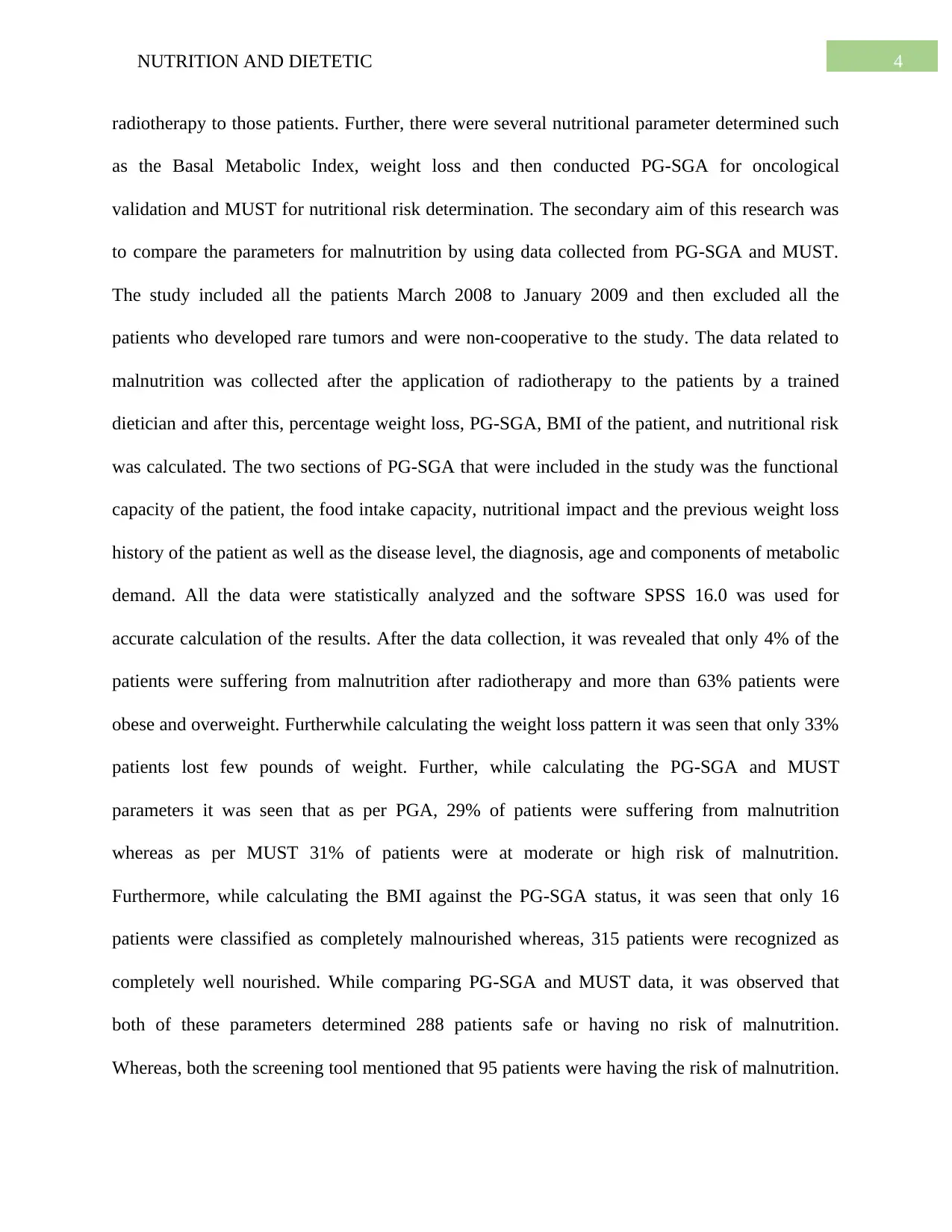
4NUTRITION AND DIETETIC
radiotherapy to those patients. Further, there were several nutritional parameter determined such
as the Basal Metabolic Index, weight loss and then conducted PG-SGA for oncological
validation and MUST for nutritional risk determination. The secondary aim of this research was
to compare the parameters for malnutrition by using data collected from PG-SGA and MUST.
The study included all the patients March 2008 to January 2009 and then excluded all the
patients who developed rare tumors and were non-cooperative to the study. The data related to
malnutrition was collected after the application of radiotherapy to the patients by a trained
dietician and after this, percentage weight loss, PG-SGA, BMI of the patient, and nutritional risk
was calculated. The two sections of PG-SGA that were included in the study was the functional
capacity of the patient, the food intake capacity, nutritional impact and the previous weight loss
history of the patient as well as the disease level, the diagnosis, age and components of metabolic
demand. All the data were statistically analyzed and the software SPSS 16.0 was used for
accurate calculation of the results. After the data collection, it was revealed that only 4% of the
patients were suffering from malnutrition after radiotherapy and more than 63% patients were
obese and overweight. Furtherwhile calculating the weight loss pattern it was seen that only 33%
patients lost few pounds of weight. Further, while calculating the PG-SGA and MUST
parameters it was seen that as per PGA, 29% of patients were suffering from malnutrition
whereas as per MUST 31% of patients were at moderate or high risk of malnutrition.
Furthermore, while calculating the BMI against the PG-SGA status, it was seen that only 16
patients were classified as completely malnourished whereas, 315 patients were recognized as
completely well nourished. While comparing PG-SGA and MUST data, it was observed that
both of these parameters determined 288 patients safe or having no risk of malnutrition.
Whereas, both the screening tool mentioned that 95 patients were having the risk of malnutrition.
radiotherapy to those patients. Further, there were several nutritional parameter determined such
as the Basal Metabolic Index, weight loss and then conducted PG-SGA for oncological
validation and MUST for nutritional risk determination. The secondary aim of this research was
to compare the parameters for malnutrition by using data collected from PG-SGA and MUST.
The study included all the patients March 2008 to January 2009 and then excluded all the
patients who developed rare tumors and were non-cooperative to the study. The data related to
malnutrition was collected after the application of radiotherapy to the patients by a trained
dietician and after this, percentage weight loss, PG-SGA, BMI of the patient, and nutritional risk
was calculated. The two sections of PG-SGA that were included in the study was the functional
capacity of the patient, the food intake capacity, nutritional impact and the previous weight loss
history of the patient as well as the disease level, the diagnosis, age and components of metabolic
demand. All the data were statistically analyzed and the software SPSS 16.0 was used for
accurate calculation of the results. After the data collection, it was revealed that only 4% of the
patients were suffering from malnutrition after radiotherapy and more than 63% patients were
obese and overweight. Furtherwhile calculating the weight loss pattern it was seen that only 33%
patients lost few pounds of weight. Further, while calculating the PG-SGA and MUST
parameters it was seen that as per PGA, 29% of patients were suffering from malnutrition
whereas as per MUST 31% of patients were at moderate or high risk of malnutrition.
Furthermore, while calculating the BMI against the PG-SGA status, it was seen that only 16
patients were classified as completely malnourished whereas, 315 patients were recognized as
completely well nourished. While comparing PG-SGA and MUST data, it was observed that
both of these parameters determined 288 patients safe or having no risk of malnutrition.
Whereas, both the screening tool mentioned that 95 patients were having the risk of malnutrition.
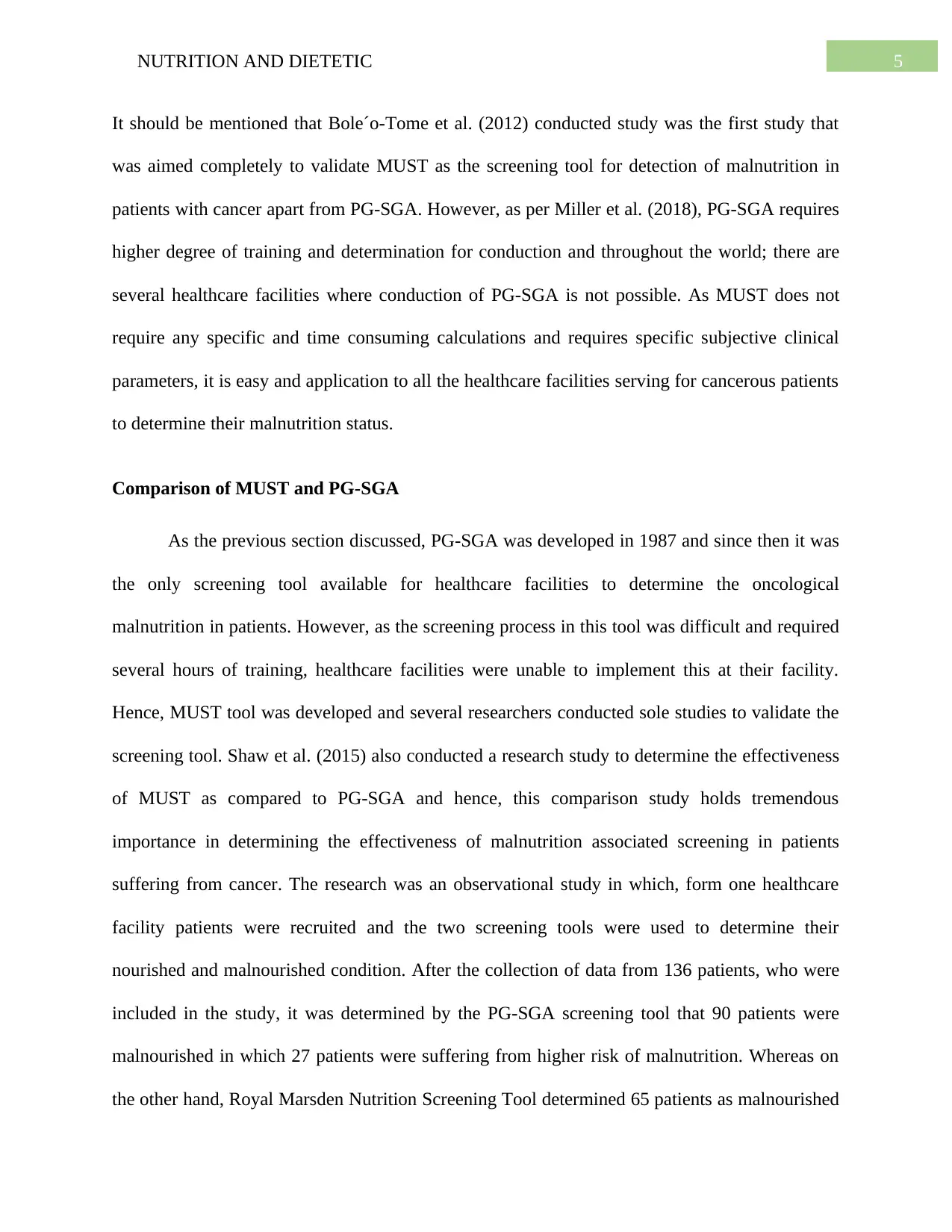
5NUTRITION AND DIETETIC
It should be mentioned that Bole´o-Tome et al. (2012) conducted study was the first study that
was aimed completely to validate MUST as the screening tool for detection of malnutrition in
patients with cancer apart from PG-SGA. However, as per Miller et al. (2018), PG-SGA requires
higher degree of training and determination for conduction and throughout the world; there are
several healthcare facilities where conduction of PG-SGA is not possible. As MUST does not
require any specific and time consuming calculations and requires specific subjective clinical
parameters, it is easy and application to all the healthcare facilities serving for cancerous patients
to determine their malnutrition status.
Comparison of MUST and PG-SGA
As the previous section discussed, PG-SGA was developed in 1987 and since then it was
the only screening tool available for healthcare facilities to determine the oncological
malnutrition in patients. However, as the screening process in this tool was difficult and required
several hours of training, healthcare facilities were unable to implement this at their facility.
Hence, MUST tool was developed and several researchers conducted sole studies to validate the
screening tool. Shaw et al. (2015) also conducted a research study to determine the effectiveness
of MUST as compared to PG-SGA and hence, this comparison study holds tremendous
importance in determining the effectiveness of malnutrition associated screening in patients
suffering from cancer. The research was an observational study in which, form one healthcare
facility patients were recruited and the two screening tools were used to determine their
nourished and malnourished condition. After the collection of data from 136 patients, who were
included in the study, it was determined by the PG-SGA screening tool that 90 patients were
malnourished in which 27 patients were suffering from higher risk of malnutrition. Whereas on
the other hand, Royal Marsden Nutrition Screening Tool determined 65 patients as malnourished
It should be mentioned that Bole´o-Tome et al. (2012) conducted study was the first study that
was aimed completely to validate MUST as the screening tool for detection of malnutrition in
patients with cancer apart from PG-SGA. However, as per Miller et al. (2018), PG-SGA requires
higher degree of training and determination for conduction and throughout the world; there are
several healthcare facilities where conduction of PG-SGA is not possible. As MUST does not
require any specific and time consuming calculations and requires specific subjective clinical
parameters, it is easy and application to all the healthcare facilities serving for cancerous patients
to determine their malnutrition status.
Comparison of MUST and PG-SGA
As the previous section discussed, PG-SGA was developed in 1987 and since then it was
the only screening tool available for healthcare facilities to determine the oncological
malnutrition in patients. However, as the screening process in this tool was difficult and required
several hours of training, healthcare facilities were unable to implement this at their facility.
Hence, MUST tool was developed and several researchers conducted sole studies to validate the
screening tool. Shaw et al. (2015) also conducted a research study to determine the effectiveness
of MUST as compared to PG-SGA and hence, this comparison study holds tremendous
importance in determining the effectiveness of malnutrition associated screening in patients
suffering from cancer. The research was an observational study in which, form one healthcare
facility patients were recruited and the two screening tools were used to determine their
nourished and malnourished condition. After the collection of data from 136 patients, who were
included in the study, it was determined by the PG-SGA screening tool that 90 patients were
malnourished in which 27 patients were suffering from higher risk of malnutrition. Whereas on
the other hand, Royal Marsden Nutrition Screening Tool determined 65 patients as malnourished
⊘ This is a preview!⊘
Do you want full access?
Subscribe today to unlock all pages.

Trusted by 1+ million students worldwide
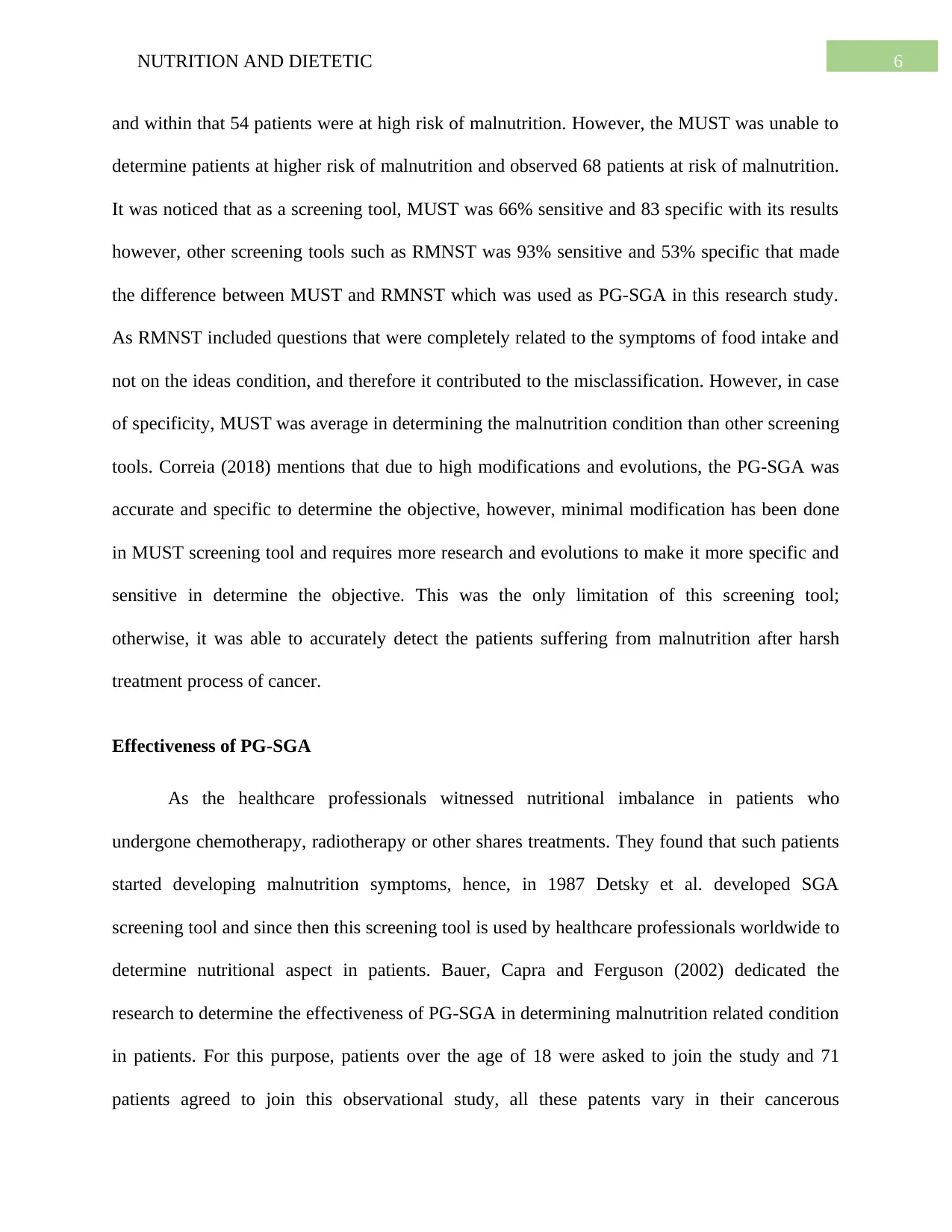
6NUTRITION AND DIETETIC
and within that 54 patients were at high risk of malnutrition. However, the MUST was unable to
determine patients at higher risk of malnutrition and observed 68 patients at risk of malnutrition.
It was noticed that as a screening tool, MUST was 66% sensitive and 83 specific with its results
however, other screening tools such as RMNST was 93% sensitive and 53% specific that made
the difference between MUST and RMNST which was used as PG-SGA in this research study.
As RMNST included questions that were completely related to the symptoms of food intake and
not on the ideas condition, and therefore it contributed to the misclassification. However, in case
of specificity, MUST was average in determining the malnutrition condition than other screening
tools. Correia (2018) mentions that due to high modifications and evolutions, the PG-SGA was
accurate and specific to determine the objective, however, minimal modification has been done
in MUST screening tool and requires more research and evolutions to make it more specific and
sensitive in determine the objective. This was the only limitation of this screening tool;
otherwise, it was able to accurately detect the patients suffering from malnutrition after harsh
treatment process of cancer.
Effectiveness of PG-SGA
As the healthcare professionals witnessed nutritional imbalance in patients who
undergone chemotherapy, radiotherapy or other shares treatments. They found that such patients
started developing malnutrition symptoms, hence, in 1987 Detsky et al. developed SGA
screening tool and since then this screening tool is used by healthcare professionals worldwide to
determine nutritional aspect in patients. Bauer, Capra and Ferguson (2002) dedicated the
research to determine the effectiveness of PG-SGA in determining malnutrition related condition
in patients. For this purpose, patients over the age of 18 were asked to join the study and 71
patients agreed to join this observational study, all these patents vary in their cancerous
and within that 54 patients were at high risk of malnutrition. However, the MUST was unable to
determine patients at higher risk of malnutrition and observed 68 patients at risk of malnutrition.
It was noticed that as a screening tool, MUST was 66% sensitive and 83 specific with its results
however, other screening tools such as RMNST was 93% sensitive and 53% specific that made
the difference between MUST and RMNST which was used as PG-SGA in this research study.
As RMNST included questions that were completely related to the symptoms of food intake and
not on the ideas condition, and therefore it contributed to the misclassification. However, in case
of specificity, MUST was average in determining the malnutrition condition than other screening
tools. Correia (2018) mentions that due to high modifications and evolutions, the PG-SGA was
accurate and specific to determine the objective, however, minimal modification has been done
in MUST screening tool and requires more research and evolutions to make it more specific and
sensitive in determine the objective. This was the only limitation of this screening tool;
otherwise, it was able to accurately detect the patients suffering from malnutrition after harsh
treatment process of cancer.
Effectiveness of PG-SGA
As the healthcare professionals witnessed nutritional imbalance in patients who
undergone chemotherapy, radiotherapy or other shares treatments. They found that such patients
started developing malnutrition symptoms, hence, in 1987 Detsky et al. developed SGA
screening tool and since then this screening tool is used by healthcare professionals worldwide to
determine nutritional aspect in patients. Bauer, Capra and Ferguson (2002) dedicated the
research to determine the effectiveness of PG-SGA in determining malnutrition related condition
in patients. For this purpose, patients over the age of 18 were asked to join the study and 71
patients agreed to join this observational study, all these patents vary in their cancerous
Paraphrase This Document
Need a fresh take? Get an instant paraphrase of this document with our AI Paraphraser
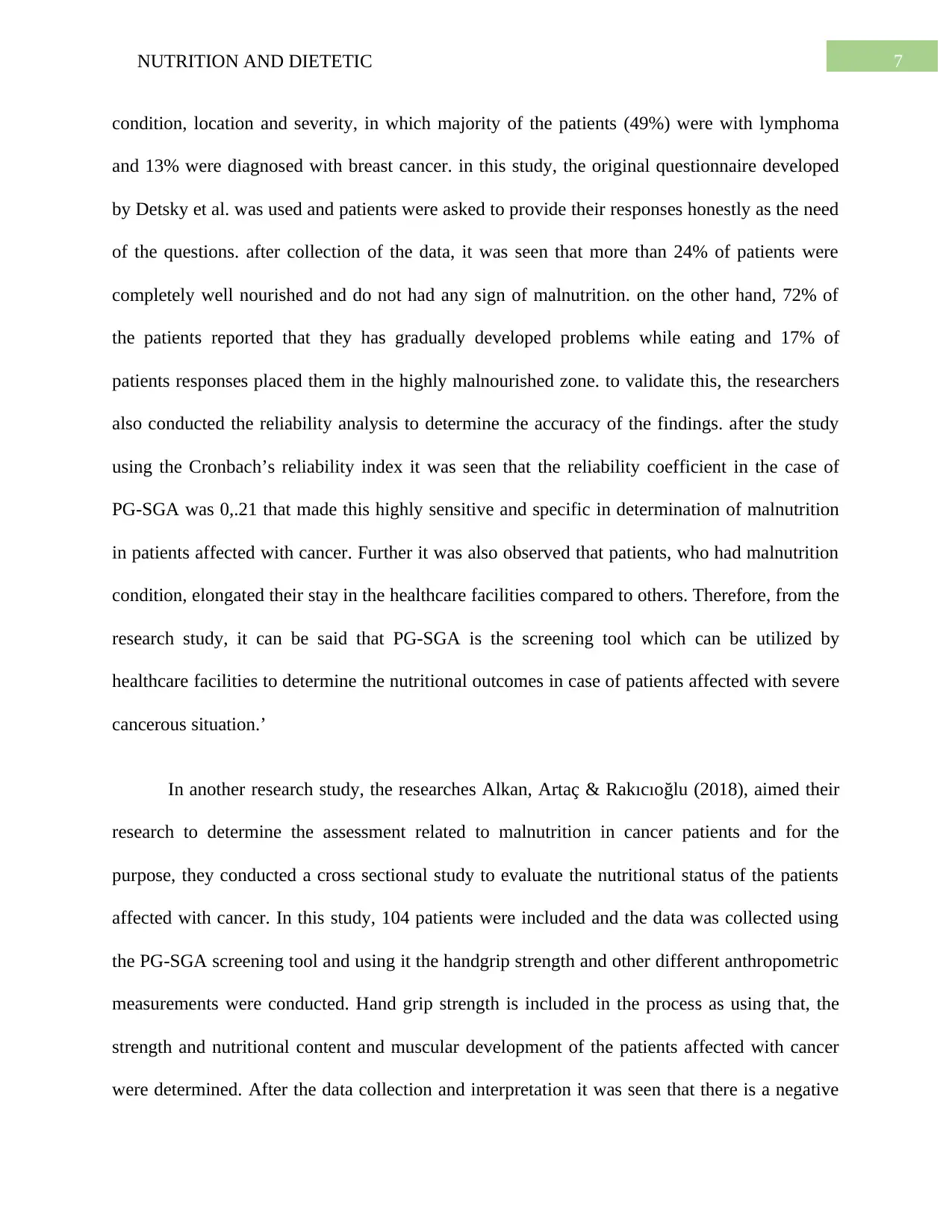
7NUTRITION AND DIETETIC
condition, location and severity, in which majority of the patients (49%) were with lymphoma
and 13% were diagnosed with breast cancer. in this study, the original questionnaire developed
by Detsky et al. was used and patients were asked to provide their responses honestly as the need
of the questions. after collection of the data, it was seen that more than 24% of patients were
completely well nourished and do not had any sign of malnutrition. on the other hand, 72% of
the patients reported that they has gradually developed problems while eating and 17% of
patients responses placed them in the highly malnourished zone. to validate this, the researchers
also conducted the reliability analysis to determine the accuracy of the findings. after the study
using the Cronbach’s reliability index it was seen that the reliability coefficient in the case of
PG-SGA was 0,.21 that made this highly sensitive and specific in determination of malnutrition
in patients affected with cancer. Further it was also observed that patients, who had malnutrition
condition, elongated their stay in the healthcare facilities compared to others. Therefore, from the
research study, it can be said that PG-SGA is the screening tool which can be utilized by
healthcare facilities to determine the nutritional outcomes in case of patients affected with severe
cancerous situation.’
In another research study, the researches Alkan, Artaç & Rakıcıoğ lu (2018), aimed their
research to determine the assessment related to malnutrition in cancer patients and for the
purpose, they conducted a cross sectional study to evaluate the nutritional status of the patients
affected with cancer. In this study, 104 patients were included and the data was collected using
the PG-SGA screening tool and using it the handgrip strength and other different anthropometric
measurements were conducted. Hand grip strength is included in the process as using that, the
strength and nutritional content and muscular development of the patients affected with cancer
were determined. After the data collection and interpretation it was seen that there is a negative
condition, location and severity, in which majority of the patients (49%) were with lymphoma
and 13% were diagnosed with breast cancer. in this study, the original questionnaire developed
by Detsky et al. was used and patients were asked to provide their responses honestly as the need
of the questions. after collection of the data, it was seen that more than 24% of patients were
completely well nourished and do not had any sign of malnutrition. on the other hand, 72% of
the patients reported that they has gradually developed problems while eating and 17% of
patients responses placed them in the highly malnourished zone. to validate this, the researchers
also conducted the reliability analysis to determine the accuracy of the findings. after the study
using the Cronbach’s reliability index it was seen that the reliability coefficient in the case of
PG-SGA was 0,.21 that made this highly sensitive and specific in determination of malnutrition
in patients affected with cancer. Further it was also observed that patients, who had malnutrition
condition, elongated their stay in the healthcare facilities compared to others. Therefore, from the
research study, it can be said that PG-SGA is the screening tool which can be utilized by
healthcare facilities to determine the nutritional outcomes in case of patients affected with severe
cancerous situation.’
In another research study, the researches Alkan, Artaç & Rakıcıoğ lu (2018), aimed their
research to determine the assessment related to malnutrition in cancer patients and for the
purpose, they conducted a cross sectional study to evaluate the nutritional status of the patients
affected with cancer. In this study, 104 patients were included and the data was collected using
the PG-SGA screening tool and using it the handgrip strength and other different anthropometric
measurements were conducted. Hand grip strength is included in the process as using that, the
strength and nutritional content and muscular development of the patients affected with cancer
were determined. After the data collection and interpretation it was seen that there is a negative
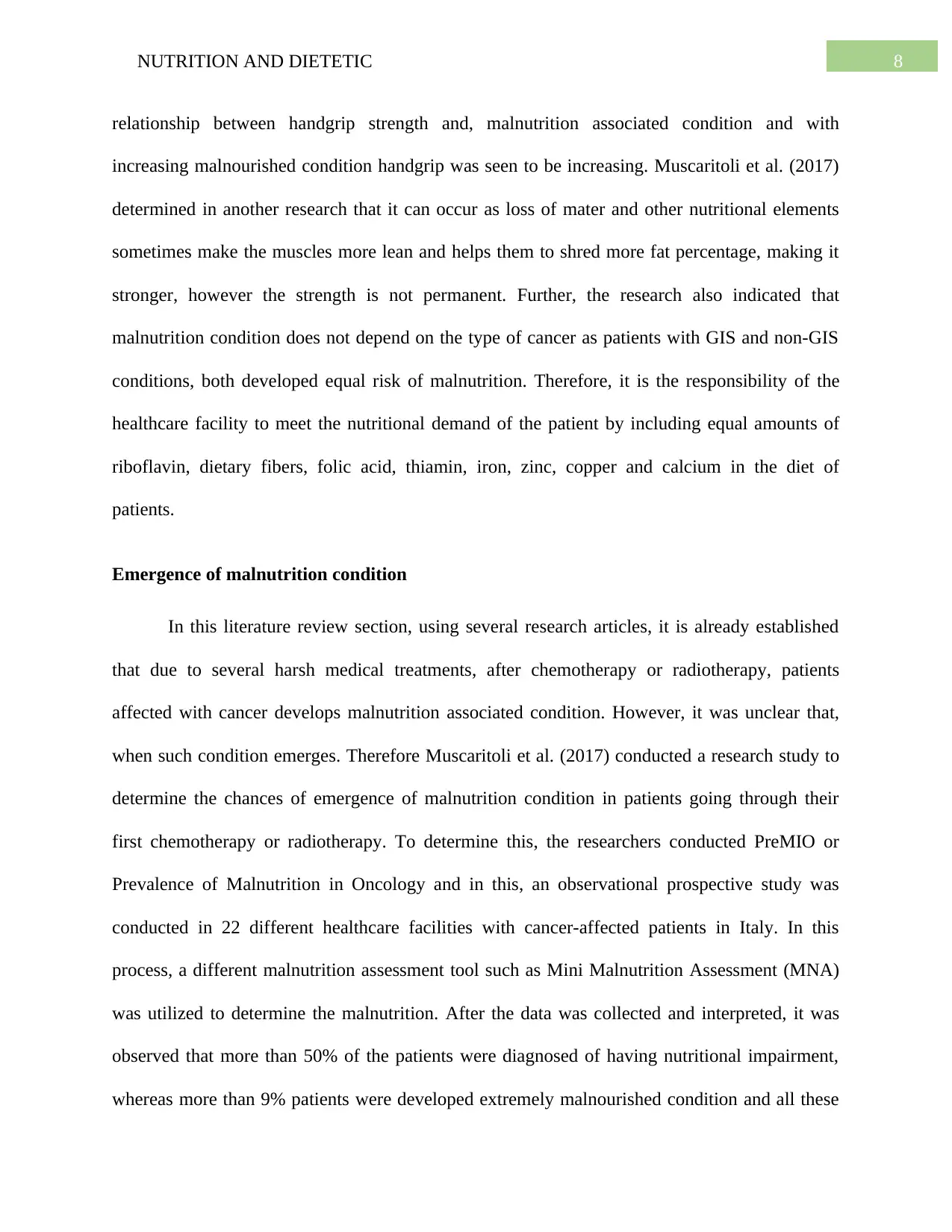
8NUTRITION AND DIETETIC
relationship between handgrip strength and, malnutrition associated condition and with
increasing malnourished condition handgrip was seen to be increasing. Muscaritoli et al. (2017)
determined in another research that it can occur as loss of mater and other nutritional elements
sometimes make the muscles more lean and helps them to shred more fat percentage, making it
stronger, however the strength is not permanent. Further, the research also indicated that
malnutrition condition does not depend on the type of cancer as patients with GIS and non-GIS
conditions, both developed equal risk of malnutrition. Therefore, it is the responsibility of the
healthcare facility to meet the nutritional demand of the patient by including equal amounts of
riboflavin, dietary fibers, folic acid, thiamin, iron, zinc, copper and calcium in the diet of
patients.
Emergence of malnutrition condition
In this literature review section, using several research articles, it is already established
that due to several harsh medical treatments, after chemotherapy or radiotherapy, patients
affected with cancer develops malnutrition associated condition. However, it was unclear that,
when such condition emerges. Therefore Muscaritoli et al. (2017) conducted a research study to
determine the chances of emergence of malnutrition condition in patients going through their
first chemotherapy or radiotherapy. To determine this, the researchers conducted PreMIO or
Prevalence of Malnutrition in Oncology and in this, an observational prospective study was
conducted in 22 different healthcare facilities with cancer-affected patients in Italy. In this
process, a different malnutrition assessment tool such as Mini Malnutrition Assessment (MNA)
was utilized to determine the malnutrition. After the data was collected and interpreted, it was
observed that more than 50% of the patients were diagnosed of having nutritional impairment,
whereas more than 9% patients were developed extremely malnourished condition and all these
relationship between handgrip strength and, malnutrition associated condition and with
increasing malnourished condition handgrip was seen to be increasing. Muscaritoli et al. (2017)
determined in another research that it can occur as loss of mater and other nutritional elements
sometimes make the muscles more lean and helps them to shred more fat percentage, making it
stronger, however the strength is not permanent. Further, the research also indicated that
malnutrition condition does not depend on the type of cancer as patients with GIS and non-GIS
conditions, both developed equal risk of malnutrition. Therefore, it is the responsibility of the
healthcare facility to meet the nutritional demand of the patient by including equal amounts of
riboflavin, dietary fibers, folic acid, thiamin, iron, zinc, copper and calcium in the diet of
patients.
Emergence of malnutrition condition
In this literature review section, using several research articles, it is already established
that due to several harsh medical treatments, after chemotherapy or radiotherapy, patients
affected with cancer develops malnutrition associated condition. However, it was unclear that,
when such condition emerges. Therefore Muscaritoli et al. (2017) conducted a research study to
determine the chances of emergence of malnutrition condition in patients going through their
first chemotherapy or radiotherapy. To determine this, the researchers conducted PreMIO or
Prevalence of Malnutrition in Oncology and in this, an observational prospective study was
conducted in 22 different healthcare facilities with cancer-affected patients in Italy. In this
process, a different malnutrition assessment tool such as Mini Malnutrition Assessment (MNA)
was utilized to determine the malnutrition. After the data was collected and interpreted, it was
observed that more than 50% of the patients were diagnosed of having nutritional impairment,
whereas more than 9% patients were developed extremely malnourished condition and all these
⊘ This is a preview!⊘
Do you want full access?
Subscribe today to unlock all pages.

Trusted by 1+ million students worldwide
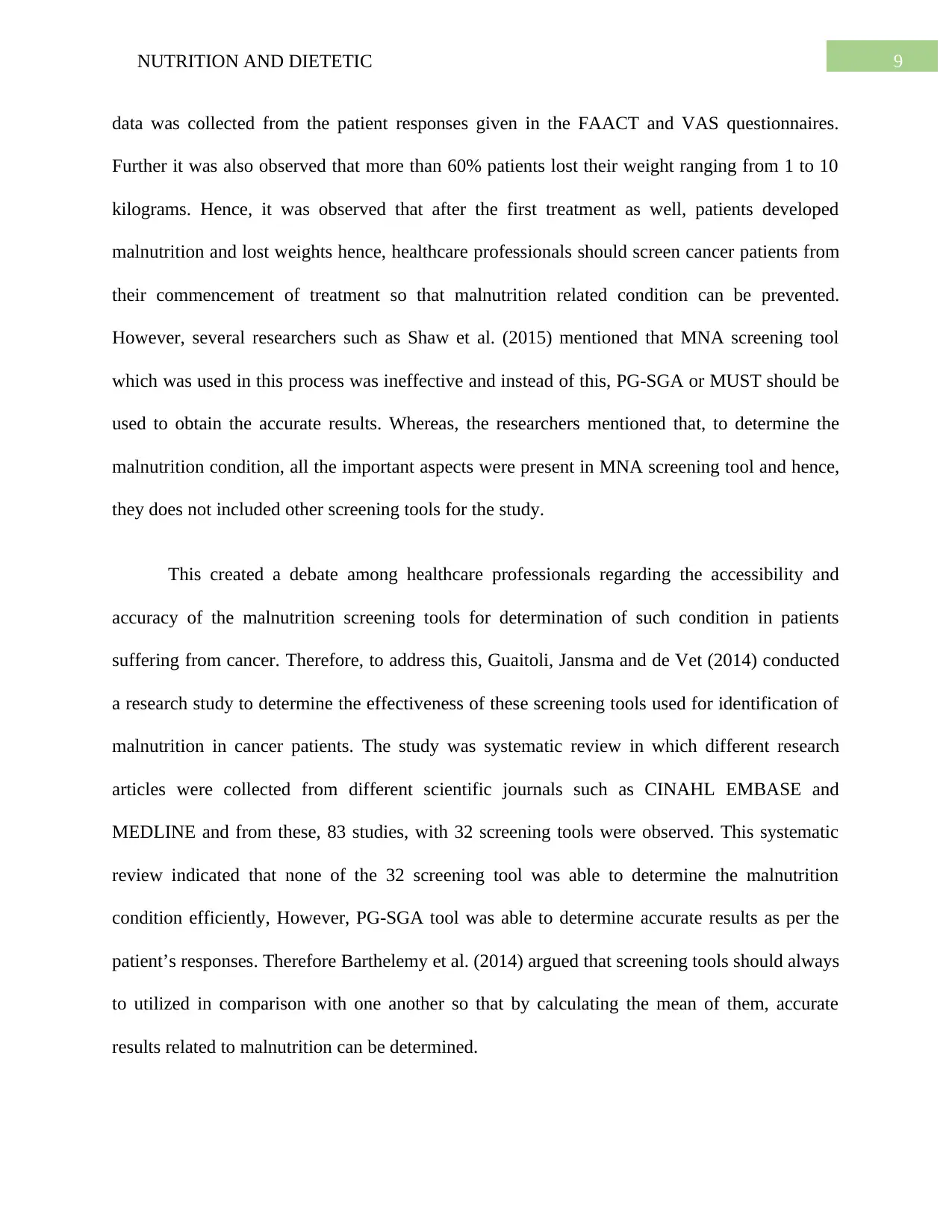
9NUTRITION AND DIETETIC
data was collected from the patient responses given in the FAACT and VAS questionnaires.
Further it was also observed that more than 60% patients lost their weight ranging from 1 to 10
kilograms. Hence, it was observed that after the first treatment as well, patients developed
malnutrition and lost weights hence, healthcare professionals should screen cancer patients from
their commencement of treatment so that malnutrition related condition can be prevented.
However, several researchers such as Shaw et al. (2015) mentioned that MNA screening tool
which was used in this process was ineffective and instead of this, PG-SGA or MUST should be
used to obtain the accurate results. Whereas, the researchers mentioned that, to determine the
malnutrition condition, all the important aspects were present in MNA screening tool and hence,
they does not included other screening tools for the study.
This created a debate among healthcare professionals regarding the accessibility and
accuracy of the malnutrition screening tools for determination of such condition in patients
suffering from cancer. Therefore, to address this, Guaitoli, Jansma and de Vet (2014) conducted
a research study to determine the effectiveness of these screening tools used for identification of
malnutrition in cancer patients. The study was systematic review in which different research
articles were collected from different scientific journals such as CINAHL EMBASE and
MEDLINE and from these, 83 studies, with 32 screening tools were observed. This systematic
review indicated that none of the 32 screening tool was able to determine the malnutrition
condition efficiently, However, PG-SGA tool was able to determine accurate results as per the
patient’s responses. Therefore Barthelemy et al. (2014) argued that screening tools should always
to utilized in comparison with one another so that by calculating the mean of them, accurate
results related to malnutrition can be determined.
data was collected from the patient responses given in the FAACT and VAS questionnaires.
Further it was also observed that more than 60% patients lost their weight ranging from 1 to 10
kilograms. Hence, it was observed that after the first treatment as well, patients developed
malnutrition and lost weights hence, healthcare professionals should screen cancer patients from
their commencement of treatment so that malnutrition related condition can be prevented.
However, several researchers such as Shaw et al. (2015) mentioned that MNA screening tool
which was used in this process was ineffective and instead of this, PG-SGA or MUST should be
used to obtain the accurate results. Whereas, the researchers mentioned that, to determine the
malnutrition condition, all the important aspects were present in MNA screening tool and hence,
they does not included other screening tools for the study.
This created a debate among healthcare professionals regarding the accessibility and
accuracy of the malnutrition screening tools for determination of such condition in patients
suffering from cancer. Therefore, to address this, Guaitoli, Jansma and de Vet (2014) conducted
a research study to determine the effectiveness of these screening tools used for identification of
malnutrition in cancer patients. The study was systematic review in which different research
articles were collected from different scientific journals such as CINAHL EMBASE and
MEDLINE and from these, 83 studies, with 32 screening tools were observed. This systematic
review indicated that none of the 32 screening tool was able to determine the malnutrition
condition efficiently, However, PG-SGA tool was able to determine accurate results as per the
patient’s responses. Therefore Barthelemy et al. (2014) argued that screening tools should always
to utilized in comparison with one another so that by calculating the mean of them, accurate
results related to malnutrition can be determined.
Paraphrase This Document
Need a fresh take? Get an instant paraphrase of this document with our AI Paraphraser
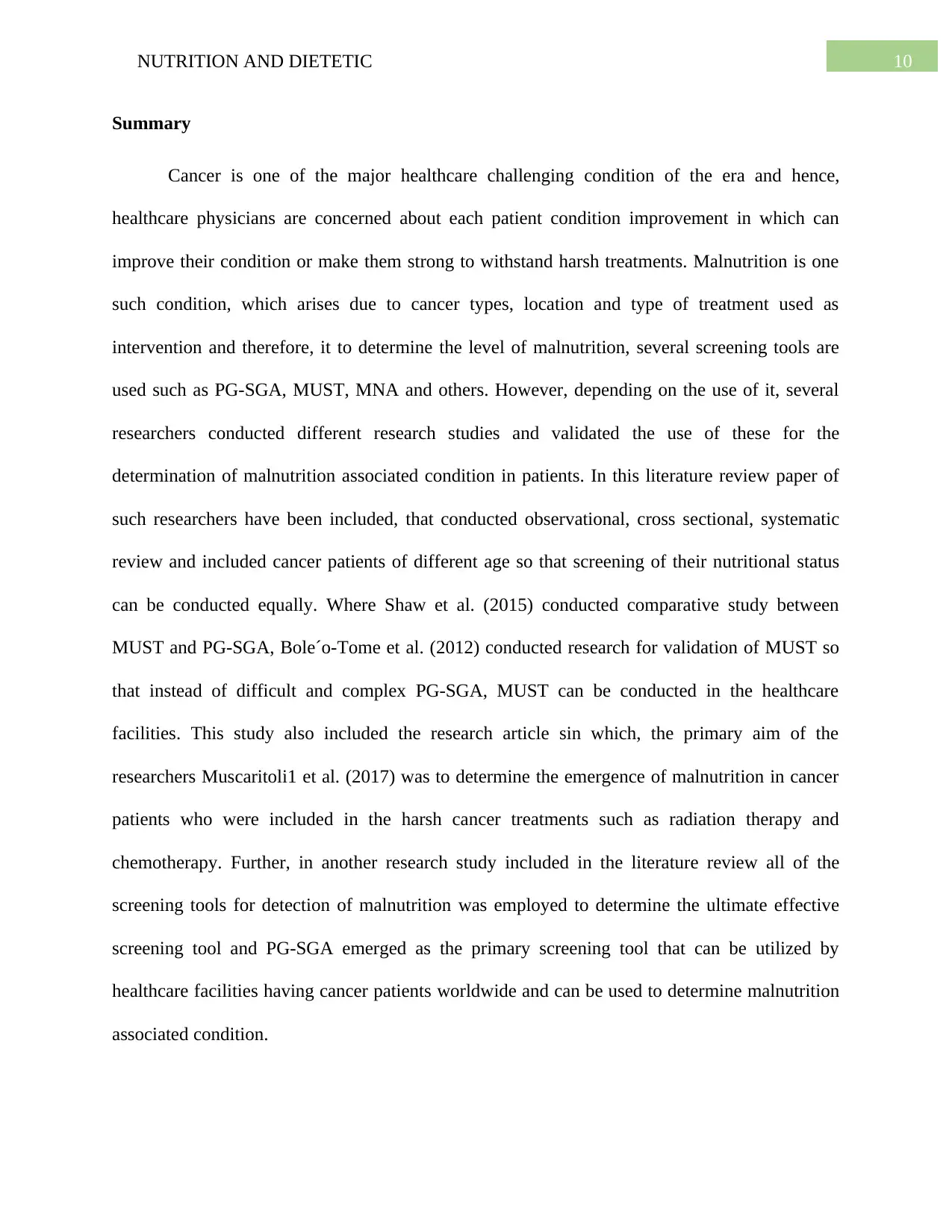
10NUTRITION AND DIETETIC
Summary
Cancer is one of the major healthcare challenging condition of the era and hence,
healthcare physicians are concerned about each patient condition improvement in which can
improve their condition or make them strong to withstand harsh treatments. Malnutrition is one
such condition, which arises due to cancer types, location and type of treatment used as
intervention and therefore, it to determine the level of malnutrition, several screening tools are
used such as PG-SGA, MUST, MNA and others. However, depending on the use of it, several
researchers conducted different research studies and validated the use of these for the
determination of malnutrition associated condition in patients. In this literature review paper of
such researchers have been included, that conducted observational, cross sectional, systematic
review and included cancer patients of different age so that screening of their nutritional status
can be conducted equally. Where Shaw et al. (2015) conducted comparative study between
MUST and PG-SGA, Bole´o-Tome et al. (2012) conducted research for validation of MUST so
that instead of difficult and complex PG-SGA, MUST can be conducted in the healthcare
facilities. This study also included the research article sin which, the primary aim of the
researchers Muscaritoli1 et al. (2017) was to determine the emergence of malnutrition in cancer
patients who were included in the harsh cancer treatments such as radiation therapy and
chemotherapy. Further, in another research study included in the literature review all of the
screening tools for detection of malnutrition was employed to determine the ultimate effective
screening tool and PG-SGA emerged as the primary screening tool that can be utilized by
healthcare facilities having cancer patients worldwide and can be used to determine malnutrition
associated condition.
Summary
Cancer is one of the major healthcare challenging condition of the era and hence,
healthcare physicians are concerned about each patient condition improvement in which can
improve their condition or make them strong to withstand harsh treatments. Malnutrition is one
such condition, which arises due to cancer types, location and type of treatment used as
intervention and therefore, it to determine the level of malnutrition, several screening tools are
used such as PG-SGA, MUST, MNA and others. However, depending on the use of it, several
researchers conducted different research studies and validated the use of these for the
determination of malnutrition associated condition in patients. In this literature review paper of
such researchers have been included, that conducted observational, cross sectional, systematic
review and included cancer patients of different age so that screening of their nutritional status
can be conducted equally. Where Shaw et al. (2015) conducted comparative study between
MUST and PG-SGA, Bole´o-Tome et al. (2012) conducted research for validation of MUST so
that instead of difficult and complex PG-SGA, MUST can be conducted in the healthcare
facilities. This study also included the research article sin which, the primary aim of the
researchers Muscaritoli1 et al. (2017) was to determine the emergence of malnutrition in cancer
patients who were included in the harsh cancer treatments such as radiation therapy and
chemotherapy. Further, in another research study included in the literature review all of the
screening tools for detection of malnutrition was employed to determine the ultimate effective
screening tool and PG-SGA emerged as the primary screening tool that can be utilized by
healthcare facilities having cancer patients worldwide and can be used to determine malnutrition
associated condition.
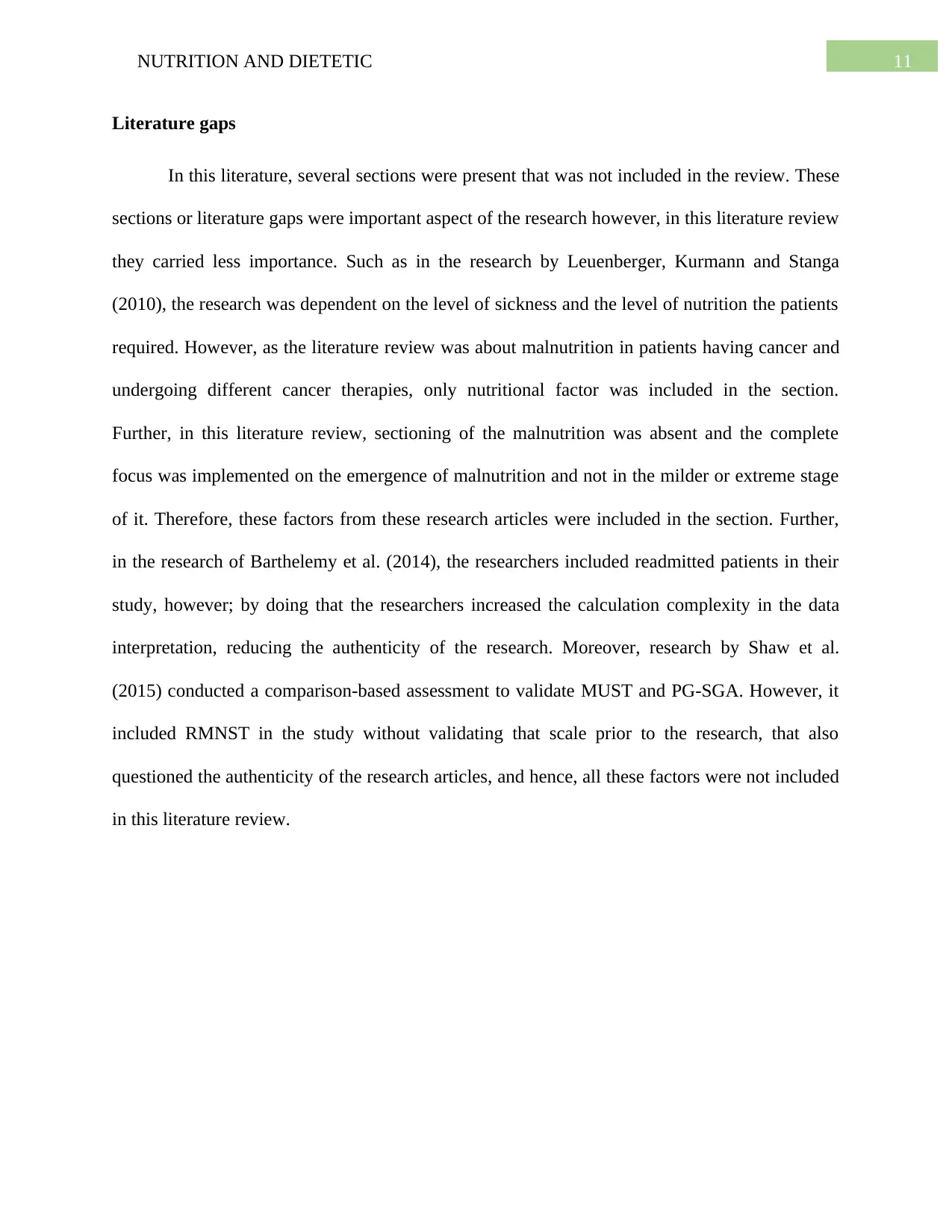
11NUTRITION AND DIETETIC
Literature gaps
In this literature, several sections were present that was not included in the review. These
sections or literature gaps were important aspect of the research however, in this literature review
they carried less importance. Such as in the research by Leuenberger, Kurmann and Stanga
(2010), the research was dependent on the level of sickness and the level of nutrition the patients
required. However, as the literature review was about malnutrition in patients having cancer and
undergoing different cancer therapies, only nutritional factor was included in the section.
Further, in this literature review, sectioning of the malnutrition was absent and the complete
focus was implemented on the emergence of malnutrition and not in the milder or extreme stage
of it. Therefore, these factors from these research articles were included in the section. Further,
in the research of Barthelemy et al. (2014), the researchers included readmitted patients in their
study, however; by doing that the researchers increased the calculation complexity in the data
interpretation, reducing the authenticity of the research. Moreover, research by Shaw et al.
(2015) conducted a comparison-based assessment to validate MUST and PG-SGA. However, it
included RMNST in the study without validating that scale prior to the research, that also
questioned the authenticity of the research articles, and hence, all these factors were not included
in this literature review.
Literature gaps
In this literature, several sections were present that was not included in the review. These
sections or literature gaps were important aspect of the research however, in this literature review
they carried less importance. Such as in the research by Leuenberger, Kurmann and Stanga
(2010), the research was dependent on the level of sickness and the level of nutrition the patients
required. However, as the literature review was about malnutrition in patients having cancer and
undergoing different cancer therapies, only nutritional factor was included in the section.
Further, in this literature review, sectioning of the malnutrition was absent and the complete
focus was implemented on the emergence of malnutrition and not in the milder or extreme stage
of it. Therefore, these factors from these research articles were included in the section. Further,
in the research of Barthelemy et al. (2014), the researchers included readmitted patients in their
study, however; by doing that the researchers increased the calculation complexity in the data
interpretation, reducing the authenticity of the research. Moreover, research by Shaw et al.
(2015) conducted a comparison-based assessment to validate MUST and PG-SGA. However, it
included RMNST in the study without validating that scale prior to the research, that also
questioned the authenticity of the research articles, and hence, all these factors were not included
in this literature review.
⊘ This is a preview!⊘
Do you want full access?
Subscribe today to unlock all pages.

Trusted by 1+ million students worldwide
1 out of 15
Related Documents
Your All-in-One AI-Powered Toolkit for Academic Success.
+13062052269
info@desklib.com
Available 24*7 on WhatsApp / Email
![[object Object]](/_next/static/media/star-bottom.7253800d.svg)
Unlock your academic potential
Copyright © 2020–2025 A2Z Services. All Rights Reserved. Developed and managed by ZUCOL.





